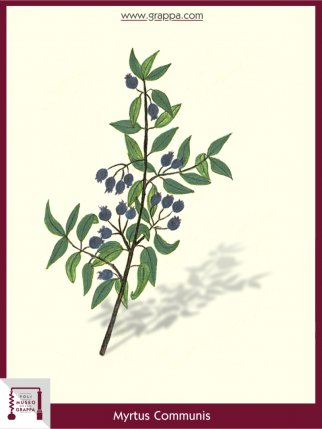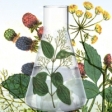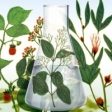Mediterranean fruit
- Plant: Common myrtle, Saharan myrtle (Myrtus Communis)
- Plant part: berry
- Plant feauters: astringent, aromatic, antiseptic, antidiarrheal, refreshing, balsamic, bactericidal, decongestant
- Description:
The Common myrtle has been very famous since ancient times: already in mythology this plant was used in veneration of Venus as a reconciliation for sacrifices.
Obviously it was a plant devoted to beauty but also to fame and heroism, so much that the heroes of mythology were crowned with myrtle. Later, it was consecrated by Christianity as a lucky symbol for young couples and so the myrtle became a typical plant at weddings. The medicinal properties of the leaves, which have always been known for their penetrating effect, reached the zenith of their fame, when the pharmacists of the sixteenth-century made and marketed a valuable distilled water ("water of angels") as a cosmetic product.
Today the myrtle enjoys a modest importance as a medicine, however a great celebrity in the kitchen.
Especially in Sardinia the berries are also used for game but also for a sweet liqueur, reminiscent of sage, laurel and a touch of resin.The Common myrtle has been very famous since ancient times: already in mythology this plant was used in veneration of Venus as a reconciliation for sacrifices.
Obviously it was a plant devoted to beauty but also to fame and heroism, so much that the heroes of mythology were crowned with myrtle. Later, it was consecrated by Christianity as a lucky symbol for young couples and so the myrtle became a typical plant at weddings. The medicinal properties of the leaves, which have always been known for their penetrating effect, reached the zenith of their fame, when the pharmacists of the sixteenth-century made and marketed a valuable distilled water ("water of angels") as a cosmetic product.
Today the myrtle enjoys a modest importance as a medicine, however a great celebrity in the kitchen.
Especially in Sardinia the berries are also used for game but also for a sweet liqueur, reminiscent of sage, laurel and a touch of resin.The Common myrtle has been very famous since ancient times: already in mythology this plant was used in veneration of Venus as a reconciliation for sacrifices.
Obviously it was a plant devoted to beauty but also to fame and heroism, so much that the heroes of mythology were crowned with myrtle. Later, it was consecrated by Christianity as a lucky symbol for young couples and so the myrtle became a typical plant at weddings. The medicinal properties of the leaves, which have always been known for their penetrating effect, reached the zenith of their fame, when the pharmacists of the sixteenth-century made and marketed a valuable distilled water ("water of angels") as a cosmetic product.
Today the myrtle enjoys a modest importance as a medicine, however a great celebrity in the kitchen.
Especially in Sardinia the berries are also used for game but also for a sweet liqueur, reminiscent of sage, laurel and a touch of resin.


- Ingredients:
- 1 liter Grappa
- 100 g of ripe berries
- 200 g of sugar syrup
- a handful of dried mint leaves
- 3 cloves and some cinnamon
- 3 dried umbels of the wild fennel - Preparation:
A "Grappa of common myrtle" has to be made with a certain circumspection: 100 g of ripe berries and 200 g of sugar syrup are added in one liter of Grappa, a handful of dried mint leaves, 3 cloves, some cinnamon and three dried umbels of wild fennel are added as well.
Leave the Grappa three months in the sun and let mature it for other three months.
The liqueur will have a dark red color as well as a soft, round flavor with the aroma of myrtle.





















































